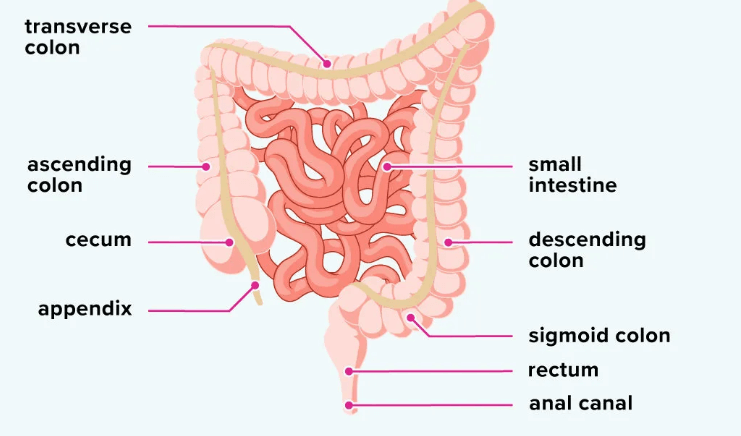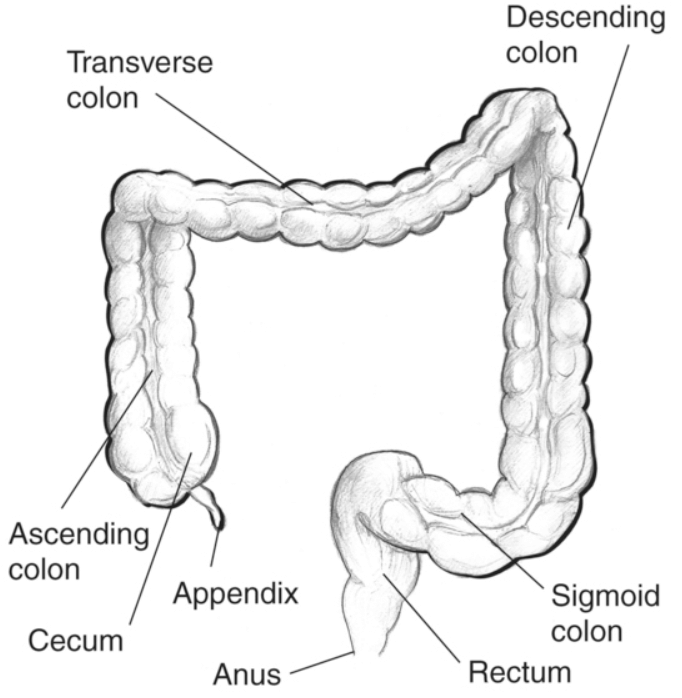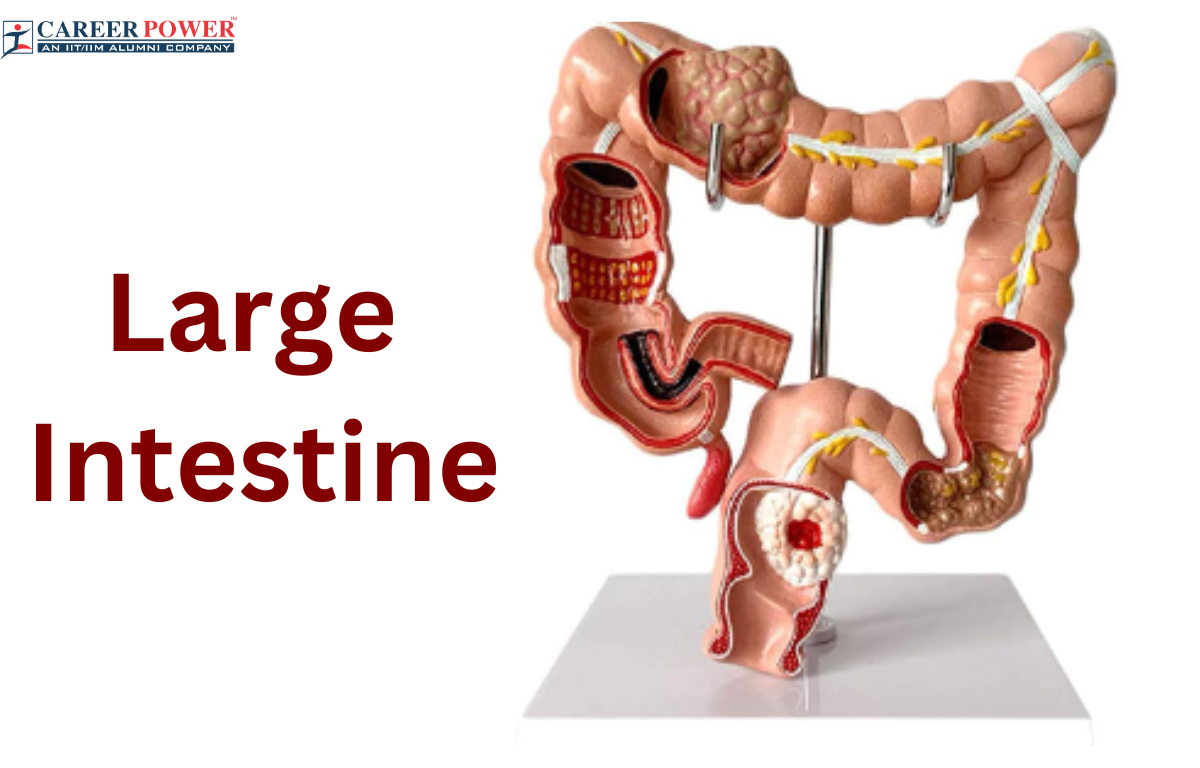The large intestine is a very important topic from unit-02 ” The World of Living” in class 10th Biology section. The digestive system is responsible for breaking down food into nutrients that the body can absorb and use for energy, growth, and repair. The digestive system is a set of different organs such as the mouth, esophagus, stomach, small intestine, and large intestine. Enzymes and other chemicals aid in the process of digestion, transforming food into smaller molecules that can be absorbed into the bloodstream. The digestive system plays a vital role in maintaining the body’s overall health and functioning. Here we will be discussing briefly about the large intestine.
Large Intestine
The large intestine is the final part of the digestive system, it is also known as the colon. The large intestine is responsible for absorbing water and electrolytes from remaining digested food, converting it into feces, and facilitating their elimination from the body. The large intestine also houses beneficial bacteria that aid in the fermentation of undigested carbohydrates, producing gases and certain vitamins. The large intestine plays a crucial role in the final stages of digestion and the elimination of waste from the body through the rectum and anus. There are three main parts of the large intestine: The Cecum, Colon, Rectum, Anal Canal, and Anus; each part plays a different role in the proper functioning of the large intestine.
Diagram of Large Intestine
The diagram of the large intestine typically shows a tube-like structure that starts at the colon and ends at the anus. As we already know that the large intestine is responsible for absorbing water and electrolytes from the remaining undigested food, forming feces, and storing them until elimination. All the parts of the large intestine are shown in the diagram below.

Functions of Large Intestine
The large intestine plays several important functions in the body. These functions collectively contribute to the final stages of digestion, waste elimination or excretion, and the maintenance of a healthy gut environment.
- Absorption of water and electrolytes: The large intestine absorbs water and electrolytes from the remaining indigestible food matter, turning the semi-liquid chyme from the small intestine into a more solid form.
- Formation of Fecal Matter: As water is absorbed, the undigested material forms into feces, which are then stored in the rectum until they are ready to be eliminated.
- Fermentation: Bacteria in the large intestine help ferment and break down certain undigested carbohydrates, producing gases and short-chain fatty acids, which can have various effects on health.
- Storage and Elimination: The large intestine stores fecal matter until it is ready to be eliminated from the body through the anus during the process of defecation or excretion.
- Elimination of Waste: The primary role of the large intestine is to eliminate waste products from the body, including indigestible food particles, dead cells, and toxins.
- Vitamin Synthesis: Some beneficial bacteria in the large intestine synthesize certain bacteria certain vitamins, such as vitamin K and some B vitamins, which are then absorbed into the body.
Parts of Large Intestine
The large intestine consists of several parts, including the Cecum, Colon, Rectum, Anal Canal, and Anus. The Colon is divided into four other parts that are: Ascending Colon, Transverse Colon, Descending Colon, and Sigmoid Colon.

These parts are involved in absorbing water and electrolytes, as well as forming and storing feces before elimination.
| Parts of Large Intestine | |
| Name of the parts | Description |
| Cecum | The cecum is the pouch-like beginning of the large intestine, which helps in receiving and partially digesting food. It also houses the Appendix. |
| Colon | The colon is the major portion of the large intestine, responsible for absorbing water, and electrolytes, and forming feces for elimination. The colon has several other divisions that are: the Ascending Colon, Transverse Colon, Descending Colon, and Sigmoid Colon |
| Rectum | The rectum is the lower part of the large intestine, storing feces before they are expelled from the body. |
| Anal Canal | The anal canal is the terminal portion of the large intestine, that leads to the anus. It is responsible for fecal elimination and sphincter control. |
| Anus | The anus is the external opening of the anal canal, serving as the exit point for waste elimination. |
Cecum
The Cecum is a pouch-like structure located at the beginning of the large intestine, specifically where the small intestine connects to the large intestine. The cecum is situated on the lower right side of the abdomen. The cecum plays a role in the digestive process by receiving and temporarily storing undigested food material from the small intestine before it moves on through the rest of the large intestine. It’s also the site where the appendix is attached. The appendix is a small, finger-like projection that doesn’t have a clearly defined function in humans but may have immune-related roles.
Colon
The colon is a very important part of the large intestine, as it is a very important component of the digestive system. The colon follows the small intestine and is responsible for absorbing water, electrolytes, and nutrients from the remaining food material after most digestion has taken place. The colon also plays a role in forming and storing feces before elimination. The colon is divided into several sections, including the ascending colon, transverse colon, descending colon, and sigmoid colon.
| Divisions of the Colon | |
| Name of the Division | Description |
| Ascending Colon | The ascending colon is the initial segment of the large intestine, responsible for absorbing water and electrolytes from digested food. |
| Transverse Colon | The transverse colon is the middle part of the large intestine, aiding in further digestion and nutrient absorption. |
| Descending Colon | The descending colon is the portion of the large intestine that moves waste material downward for eventual elimination. |
| Sigmoid Colon | The sigmoid colon is the S-shaped section of the large intestine that stores and expels fecal matter. |
Ascending Colon
The ascending colon is the first segment of the large intestine, extending from the cecum (the pouch that connects the small and large intestine) upward along the right side of the abdomen. It’s responsible for absorbing water and electrolytes from the digested food, helping to form semi-solid feces before they move into the transverse colon.
Transverse Colon
The transverse colon is the middle portion of the large intestine. It runs horizontally across the abdomen, connecting the ascending colon on the right side and the decreasing colon on the left side. The main function of the transverse colon is to further absorb water and nutrients from the digestive material, as well as to aid in the formation of feces before they enter the descending colon for further processing.
Descending Colon
The descending colon is part of the large intestine that runs vertically down the left side of the abdomen, connecting the transverse colon to the sigmoid colon. It’s responsible for further water absorption and the consolidation of feces as they continue their journey through the digestive system. The descending colon eventually leads to the sigmoid colon, which is the last segment of the colon before the rectum.
Sigmoid Colon
The sigmoid colon is the curved section of the large intestine that help in connecting the descending colon to the rectum. The S-shape of the sigmoid curve gives it, its name. The sigmoid colon is located in the lower left side of the abdomen. The sigmoid colon plays a role in further water absorption and the formation of feces, helping to store them until they are ready to be eliminated from the body through the rectum and anus.
Rectum
The rectum is the terminal or the final part of the large intestine. The rectum is a muscular tube that follows the sigmoid colon and precedes the anus. The rectum is about 4 to 6 inches long and has a stretchable lining that allows it to hold and store feces until they are ready to be expelled from the body. The rectum has sensory nerves that help you sense when it’s time for a bowel movement, and its muscular contractions aid in the elimination process.
Anal Canal
The anal canal is the terminal part of the large intestine, responsible for the elimination of feces from the body. It’s located between the rectum and the anus. The anal canal has two sphincters: the inner involuntary sphincter made of smooth muscle, and the outer voluntary sphincter made up of skeletal muscles. These sphincters help control the passage of stool. The anal canal also contains mucus, aiding in the lubrication of feces during evacuation.
Anus
The anus is the external opening at the end of the anal canal. It serves as the exit point for feces from the body during the process of defecation. The anus is surrounded by muscles known as anal sphincters, which play a role in controlling the passage of stools. The inner involuntary sphincter is made of smooth muscles, while the outer voluntary sphincter is composed of skeletal muscles. Together, these sphincters help regulate the timing and control of bowel movements.



 50 Vegetables Name for Kids in English a...
50 Vegetables Name for Kids in English a...
 Food Chain: Definition, Types, Examples,...
Food Chain: Definition, Types, Examples,...
 Human Respiratory System: Definition, Di...
Human Respiratory System: Definition, Di...













